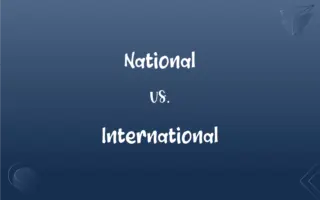Manual Filing vs. E-Filing: What's the Difference?
Edited by Janet White || By Aimie Carlson || Published on November 27, 2023
Manual filing involves physically organizing and submitting documents, while e-filing is the electronic submission of documents, often through the internet.

Key Differences
Manual filing refers to the traditional method of organizing and storing documents in physical formats such as paper folders, which are often stored in cabinets or files. E-filing, on the other hand, involves storing and organizing documents digitally, typically on a computer or cloud-based system. While manual filing is tangible and physical, e-filing is virtual and electronic.
Manual filing requires physical access to documents, making it less convenient for those who need to access files remotely. E-filing, in contrast, allows for instant access to documents from anywhere with an internet connection, increasing convenience and accessibility.
Manual filing can be susceptible to physical damage like fire, water, or theft. E-filing offers enhanced security features like encryption and backups, protecting documents from such physical threats. However, e-filing also poses risks of cyber threats like hacking.
Manually filing documents can be time-consuming, as it involves physical handling, labeling, and storage. E-filing streamlines these processes, allowing for faster organization and retrieval of documents, significantly reducing the time spent on administrative tasks.
Manual filing consumes physical resources like paper, contributing to environmental concerns like deforestation and waste. E-filing is more environmentally friendly, reducing the need for paper and physical storage materials.
ADVERTISEMENT
Comparison Chart
Medium
Physical (paper, folders)
Digital (files, databases)
Storage
Cabinets, files
Computers, cloud servers
Access
Physical presence required
Remote access possible
Security
Susceptible to physical damage
Risk of cyber threats
Efficiency
Time-consuming organization
Quick, automated processes
ADVERTISEMENT
Manual Filing and E-Filing Definitions
Manual Filing
The manual handling and sorting of documents.
Manual filing required more labor and space for storage.
E-Filing
Electronic submission of forms or paperwork.
E-filing court documents saves time for lawyers and clients alike.
Manual Filing
The process of organizing documents in physical form.
She spent the afternoon manual filing old reports into the cabinet.
E-Filing
Online management of records and data.
Her company switched to e-filing for all their employee records.
Manual Filing
Physical management and storage of paper documents.
The office’s manual filing system was meticulously organized.
E-Filing
The process of submitting documents electronically.
E-filing taxes is faster and more convenient than mailing them.
Manual Filing
Traditional method of record-keeping using paper.
Manual filing was the primary method before digital technologies.
E-Filing
The digital equivalent of manual filing.
E-filing has largely replaced the traditional filing cabinets in offices.
Manual Filing
The act of submitting paperwork by hand.
Manual filing of tax returns involved a trip to the post office.
E-Filing
Digital organization and storage of documents.
With e-filing, finding a specific document takes mere seconds.
E-Filing
The use of computer technology to file documents (in a legal case, a patent application, etc.).
FAQs
How secure is manual filing?
It's susceptible to physical damage but not to cyber threats.
Can I access manual files remotely?
No, manual filing requires physical access to the documents.
What is manual filing?
It's the traditional process of organizing and storing documents in physical formats.
What is e-filing?
E-filing is the electronic submission and organization of documents.
Is e-filing secure?
E-filing is generally secure with encryption, though it faces cyber threats.
How efficient is e-filing?
E-filing is efficient, with quick digital organization and retrieval.
Can e-filing be integrated with other systems?
Yes, e-filing can be integrated with other digital systems and software.
Can I access e-files from anywhere?
Yes, e-filing allows for remote access if you have internet connectivity.
What are common uses of manual filing?
It's often used for legal documents, historical records, and personal files.
What are common uses of e-filing?
Commonly used for tax submissions, legal documents, and corporate records.
Is training required for manual filing?
Basic training is needed for effective organization and retrieval.
Does manual filing impact the environment?
Yes, it consumes physical resources like paper and storage space.
How does e-filing handle large data volumes?
E-filing handles large volumes efficiently with digital storage solutions.
Can I back up manual files?
Physical copies can be made, but it's a labor-intensive process.
Is manual filing time-consuming?
Yes, it involves physical sorting and organizing, which takes time.
Is e-filing environmentally friendly?
Generally, yes, as it reduces the need for paper and physical storage.
Can manual filing be automated?
No, it requires manual effort and cannot be automated.
How does manual filing handle large volumes of data?
It can be challenging and space-consuming to manage large data volumes manually.
Do I need special skills for e-filing?
Basic computer skills and familiarity with digital tools are needed.
Are backups easy with e-filing?
Yes, digital files can be easily backed up and stored in multiple locations.
About Author
Written by
Aimie CarlsonAimie Carlson, holding a master's degree in English literature, is a fervent English language enthusiast. She lends her writing talents to Difference Wiki, a prominent website that specializes in comparisons, offering readers insightful analyses that both captivate and inform.
Edited by
Janet WhiteJanet White has been an esteemed writer and blogger for Difference Wiki. Holding a Master's degree in Science and Medical Journalism from the prestigious Boston University, she has consistently demonstrated her expertise and passion for her field. When she's not immersed in her work, Janet relishes her time exercising, delving into a good book, and cherishing moments with friends and family.































































